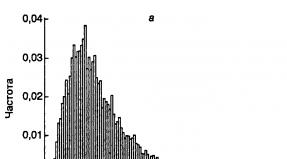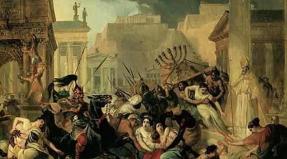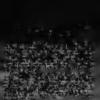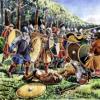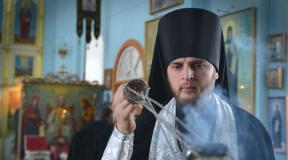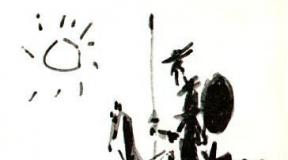The message about Dionysus is a summary. Dionysus is the Greek god of winemaking. Dionysus and Aphrodite
Dionysus Dionysus , Bacchus or Bacchus (Dionysus, Bacchus, Διόνυσος, Βάκχος). God of wine and winemaking, son of Zeus and Semele, daughter of Cadmus. Shortly before his birth, jealous Hera advised Semele to beg Zeus to come to her in all his greatness; Zeus really appeared to her with lightning and thunder, but she, like a mere mortal, could not bear his contemplation and died, giving birth to a baby prematurely. Zeus sewed the child into his thigh, where he brought him before the due date. Accompanied by a crowd of his servants, maenads and bacchantes, as well as seilens and satyrs with rods (firses) entwined with grapes, Dionysus walked through Hellas, Syria and Asia as far as India and returned to Europe through Thrace. On his way, he taught people everywhere about winemaking and the first beginnings of civilization. The wife of Dionysus was considered Ariadne, abandoned by Theseus on the island of Naxos. The cult of Dionysus, which at first had a cheerful character, gradually became more and more incontinent and passed into violent orgies, or bacchanalia. Hence the name of Dionysus - Bacchus, i.e. noisy. A special role in these festivals was played by the priestesses of Dionysus - frenzied women known as maenads, bacchantes, etc. Dionysus was dedicated to grapes, ivy, panther, lynx, tiger, donkey, dolphin and goat. The Roman god Bacchus corresponded to the Greek Dionysus. (Source: "Concise Dictionary of Mythology and Antiquities". M. Korsh. St. Petersburg, edition of A. Suvorin, 1894.)
(Διόνυσος), Bacchus, Bacchus, in Greek mythology, the god of the fertile forces of the earth, vegetation, viticulture, winemaking. The deity of Eastern (Thracian and Lydian-Phrygian) origin, spread in Greece relatively late and with great difficulty established there. Although the name D. is found on the tablets of the Cretan Linear "B" as early as the 14th century. BC e., the spread and establishment of the cult of D. in Greece dates back to the 8-7 centuries. BC e. and is associated with the growth of city-states (policies) and the development of polis democracy. During this period, the cult of D. began to supplant the cults of local gods and heroes. D. as a deity of the agricultural circle, associated with the elemental forces of the earth, was constantly opposed Apollo - as, above all, the deity of the tribal aristocracy. The popular basis of the cult of D. was reflected in the myths about the illegitimate birth of a god, his struggle for the right to become one of the Olympic gods and for the widespread establishment of his cult. Many monuments of ancient art have survived, embodying the image of D. and the plots of myths about him (D.'s love for Ariadne and others) in plastic (statues and reliefs) and vase painting. Scenes of the procession of D. and his companions, orgy, were widespread (especially in vase painting); these subjects are reflected in the reliefs of the sarcophagi. D. was depicted among the Olympians (reliefs of the eastern frieze of the Parthenon) and in scenes of gigantomachy, as well as sailing on the sea (Kilik Eksekia "D. in the boat" and others) and fighting the Tyrrhenians (relief of the monument to Lysicrates in Athens, c. 335 BC e.). In medieval book illustrations, D. was usually depicted as the personification of autumn - the time of harvest (sometimes only in October). During the Renaissance, the theme of dialecticism in art was associated with the assertion of the joy of being; become widespread since the 15th century. scenes of orgy (the beginning of their depiction was put by A. Mantegna; A. Durer, A. Altdorfer, H. Baldung Green, Titian, Giulio Romano, Pietro da Cortona, Annibale Carracci, P.P. Rubens, J. Jordaens, N. . Poussin). The plots "Bacchus, Venus and Ceres" and "Bacchus and Ceres" are permeated with the same symbolism (see article Demeter), especially popular in baroque painting. In the 15-18 centuries. popular in painting were scenes depicting the meeting of D. and Ariadne, their wedding and triumphal procession. Among the works of plasticity - reliefs "Bacchus turns Tyrrhenians into dolphins" by A. Filarete (on the bronze doors of St. Peter's Cathedral in Rome), "Meeting of Bacchus and Ariadne" by Donatello, statues "Bacchus" by Michelangelo, J. Sansovino and others. D. holds a special place among other antique characters in the garden plastic of the Baroque. The most significant works 18 - early. 19th centuries - statues "Bacchus" by J. G. Dannecker and B. Thor-waldsen. Among the musical works of the 19-20 centuries. on the plots of myth: A. Dargomyzhsky's opera-ballet "The Triumph of Bacchus", K. Debussy's divertissement "Triumph of Bacchus" and his own opera "D.", J. Massenet's opera "Bacchus" and others.
There are myths about various ancient incarnations of D., as if preparing his arrival. Archaic hypostases of D are known: Zagrei, son of Zeus of Crete and Persephone; Iacchus, associated with the Eleusinian Mysteries; D. - the son of Zeus and Demeter (Diod. Ill 62, 2-28). According to the main myth, D. is the son of Zeus and the daughter of the Theban king Cadmus. Semeles. At the instigation of the jealous Hera, Semele asked Zeus to appear to her in all his greatness, and he, presenting himself in a flash of lightning, incinerated the mortal Semele and her tower with fire. Zeus snatched D. from the flame, who was born prematurely, and sewed it into his thigh. In due time, Zeus gave birth to D., loosening the seams on his thigh (Hes. Theog. 940-942; Eur. Bacch. 1-9, 88-98, 286-297), and then gave D. through Hermes to be raised by the Nisean nymphs ( Eur. Bacch. 556-559) or Semele's sister Ino (Apollod. III 4, 3). D. found a vine. Hera instilled madness in him, and he, wandering through Egypt and Syria, came to Phrygia, where the goddess Cybele - Rhea healed him and introduced him to her orgiastic mysteries. After that, D. through Thrace went to India (Apollod. III 5, 1). From the eastern lands (from India or from Lydia and Phrygia), he returns to Greece, to Thebes. During the voyage from the island of Ikaria to the island of Naxos, D. was kidnapped by Tyrrhenian sea robbers (Apollod. III 5, 3). The robbers are horrified at the sight of D.'s amazing transformations. They chained D. in order to sell him into slavery, but the fetters themselves fell from D.'s hands; braiding the mast and sails of the ship with vines and ivy, D. appeared in the form of a bear and a lion. The pirates themselves, who threw themselves into the sea out of fear, turned into dolphins (Hymn. Hom. VII). This myth reflects the archaic plant-zoomorphic origin of D. The plant past of this god is confirmed by his epithets: Evius ("ivy", "ivy"), "bunch of grapes", etc. (Eur. Bacch. 105, 534, 566, 608). D.'s zoomorphic past is reflected in his werewolves and ideas about D. the bull (618, 920-923) and D. the goat. The phallus was the symbol of D. as the god of the fruiting forces of the earth.
On the island of Naxos, D. met his beloved Ariadne, abandoned by Theseus, kidnapped her and married her on the island of Lemnos; from him she gave birth to Enopion, Foant and others (Apollod. epit. I 9). Wherever D. appears, he establishes his own cult; everywhere on its way teaches people viticulture and winemaking. In the procession of D., which was of an ecstatic nature, Bacchantes, satyrs, maenads, or bassarids (one of the nicknames of D. - Bassare) with thyrsus (wands) entwined with ivy took part. Belted with snakes, they crushed everything in their path, seized by sacred madness. With cries of "Bacchus, Evoe" they praised D.-Bromius ("stormy", "noisy"), beat the tympans, reveling in the blood of torn wild animals, carving honey and milk from the ground with their thyrsi, uprooting trees and dragging them along crowds of women and men (Eur. Bacch. 135-167, 680-770). D. is famous as Liei ("liberator"), he frees people from worldly concerns, removes from them the shackles of measured life, breaks the shackles with which enemies are trying to entangle him, and breaks down walls (616-626). He sends madness to enemies and punishes them terribly; so he did with his cousin the Theban king Pentheus, who wanted to prohibit the Bacchic rampages. Pentheus was torn to pieces by Bacchantes led by his mother Agave, mistaken in a state of ecstasy her son for an animal (Apollod. III 5, 2; Eur. Bacch. 1061-1152). On Lycurgus, the son of the king of the Aedons, who opposed the cult of D., God sent madness, and then Lycurgus was torn to pieces by his own horses (Apollod. III 5, 1).
D. entered the number of the 12 Olympic gods late. At Delphi, he began to be revered along with Apollo. On Parnassus, every two years, orgies were held in honor of D., in which fiades - bacchantes from Attica (Paus. X 4, 3) participated. In Athens, solemn processions were organized in honor of D. and the sacred marriage of God with the wife of the archon Basileus was played out (Aristot. Rep. Athen. III 3). Ancient Greek tragedy arose from the religious and cult rites dedicated to D. (Greek tragodia, literally "song of the goat" or "song of the goats", that is, goat-footed satyrs - D.'s companions). In Attica, D. were dedicated to the Great, or City, Dionysias, which included solemn processions in honor of God, contests between tragic and comic poets, and choirs performing praises (held in March – April); Lenei, which included the performance of new comedies (in January - February); Small, or Rural, Dionysias, which preserved remnants of agricultural magic (in December - January), when the dramas already played in the city were repeated.
In Hellenistic times, the cult of D. merged with the cult of the Phrygian god Sabazia (Sabaziy became D.'s constant nickname). In Rome, D. was revered under the name Bacchus (hence the bacchante, bacchanalia) or Bacchus. Identified with Osiris, Serapis, Mithras, Adonis, Amun, Lieber.
Lit .: Losev A.F., Ancient mythology in its historical development, M., 1957, p. 142-82; F. Nietzsche, The Birth of Tragedy from the Spirit of Music, Poln. gathering cit., vol. 1, [M.], 1912; Otto W. P., Dionysos. Mythos und Kultus, 2 Aufl .. Fr./M .. 1939; Jünger F. G., Griechische Götter. Apollon, Pan, Dionysos. Fr./M., 1943; Meautis G., Dionysos ou Ie pouvoir de fascination, in his book: Mythes inconnus de la Grèce antique. P., pp. 33-63; Jeanmaire H., Dionysos. Histoire du culte de Bacchus, P., 1951.
A.F. Losev.
(Source: Myths of the Nations of the World.)
Dionysus(Bacchus, Bacchus) - the god of viticulture and winemaking, the son of Zeus and Hera (according to other sources of Zeus and the Theban princess and the goddess Semele, according to other sources of Zeus and Persephone). In honor of Dionysus, festivities were held - Dionysius and Bacchanalia.
// Adolphe-William BUGRO: Childhood of Bacchus // Nicola PUSSEN: Midas and Bacchus // Franz von STUK: Boy Bacchus riding a panther // TITIAN: Bacchus and Ariadne // Apollo Nikolaevich MAIKOV: Bacchus // Constantinos KAVAFIS: Retinue of Dionysus / / Dmitry OLERON: Gerayon. Hermes and Bacchus Praxiteles. Bacchus // A.S. PUSHKIN: Triumph of Bacchus // N.A. Kuhn: DIONYSUS // N.A. Kuhn: THE BIRTH AND RAISING OF DIONYSUS // N.A. Kuhn: DIONYSUS AND HIS SUIT // N.A. Kuhn: LIKURG // N.A. Kuhn: MINI'S DAUGHTERS // N.A. Kuhn: TYRRENIAN SEA BROOLS // N.A. Kuhn: ICARIUS // N.A. Kuhn: MIDAS
(Source: "Myths of Ancient Greece. Reference Dictionary." EdwART, 2009.)
DIONYSUSin Greek mythology, Zeus and Femela, the god of the fruiting forces of the earth, vegetation, viticulture and winemaking.
(Source: "Dictionary of the spirits and gods of Germanic-Scandinavian, Egyptian, Greek, Irish, Japanese mythology, Mayan and Aztec mythologies.")








See what "Dionysus" is in other dictionaries:
- (other Greek Διόνυσος) ... Wikipedia
- (Bacchus) Greek deity, the embodiment of life force. The earliest forms of the cult of D. survived in Thrace, where they had an "orgiastic" character: the participants in the cult, dressed in animal skins, in mass joy brought themselves to frenzy (ecstasy) ... Literary encyclopedia
And husband. Borrowing Rep .: Dionisovich, Dionisovna; colloquial Dionisych. Origin: (In ancient mythology: Dionysus is the god of the vital forces of nature, the god of wine.) Name days: (see Denis) Dictionary of personal names. Dionysus See Denis ... Dictionary of personal names
- (Greek Dionisos). Greek name for the god Bacchus or Bacchus. Dictionary of foreign words included in the Russian language. Chudinov AN, 1910. DIONYSUS at the ancient. Greeks the same as Bacchus, another name for the god of wine and gladness; the Romans have Bacchus. Complete dictionary ... ... Dictionary of foreign words of the Russian language
The deity of Eastern (Thracian and Lydian-Phrygian) origin, spread in Greece relatively late and with great difficulty established there. Although the name Dionysus is found on the tablets of the Cretan linear letter "B" in the XIV century. BC, the spread and establishment of the cult of Dionysus in Greece dates back to the VIII-VII centuries. BC. and is associated with the growth of city-states (policies) and the development of polis democracy.
During this period, the cult of Dionysus began to supplant the cults of local gods and heroes. Dionysus, as a deity of the agricultural circle, associated with the elemental forces of the earth, was constantly opposed to Apollo - as, first of all, the deity of the clan aristocracy. The folk basis of the cult of Dionysus was reflected in the myths about the illegitimate birth of God, his struggle for the right to become one of the Olympic gods and for the widespread establishment of his cult.
Note: the authors and titles of the paintings pop up when you hover over them.
France. Fine arts 1st century. BC e. - 17th century. F. Girardon. "Apollo and the Nymphs" (decorative group in the grotto of the park at Versailles), Marble. 1662-72.
There are myths about various ancient incarnations of Dionysus, as if preparing his arrival. The archaic hypostases of Dionysus are known: Zagreus, son of Zeus of Crete and Persephone; Iacchus associated with the Eleusinian Mysteries; Dionysus is the son of Zeus and Demeter (Diod. III 62, 2 - 28). According to the main myth, Dionysus is the son of Zeus and the daughter of the Theban king Cadmus Semele.
At the instigation of the jealous Hera, Semele asked Zeus to appear to her in all his greatness, and he, presenting himself in a flash of lightning, incinerated the mortal Semele and her tower with fire. Zeus snatched Dionysus out of the flame, who was born prematurely, and sewed him into his thigh. In due time Zeus gave birth to Dionysus, loosening the stitches not on the thigh (He. Theog. 940-942; Eur. Bacch. 1-9, 88-98, 286-297), and then gave Dionysus through Hermes to be raised by the Nisean nymphs (Eur. Bacch. 556-569) or sister of Semele Ino (Apollod. III 4, 3).
The boy who was born three months later was the god Dionysus, who, upon reaching maturity, sought out his mother in the underworld, after which Semele was transferred to Olympus. Semele's envious sisters interpreted her death as a punishment sent by Zeus for giving herself up to a mortal. Subsequently, Zeus took revenge on the sisters of Semele, sending all kinds of disasters on their sons.
The name of Semele is of Phrygian origin, it means "earth"; probably Semele was a Phrygian-Thracian deity of the earth. The myth of the birth of Dionysus from Zeus was supposed to ensure the introduction into the Olympic pantheon of a god who did not originally belong to him.
Dionysus found a vine and taught people how to make wine.
Hera instilled madness in him, and he, wandering through Egypt and Syria, came to Phrygia, where the goddess Cybele-Rhea healed him and introduced him to her orgiastic mysteries.
After this, Dionysus went through Thrace to India (Apollod. III 5, 1). From the eastern lands (from India or from Lydia and Phrygia), he returns to Greece, to Thebes. During his voyage from the island of Ikaria to the island of Naxos, Dionysus was kidnapped by sea robbers - the Tyrrhenians (Apollod. III 5, 3). The robbers are horrified at the amazing transformations of Dionysus. They bound Dionysus in chains to sell him into slavery, but the fetters themselves fell from the hands of Dionysus; braiding with vines and ivy the mast, the sails of the ship, Dionysus appeared in the form of a bear and a lion. The pirates themselves, who threw themselves into the sea out of fear, turned into dolphins (Hymn. Nom. VII).
This myth reflected the archaic plant-zoomorphic origin of Dionysus. The vegetative past of this god is confirmed by his epithets: Evius ("ivy", "ivy"), "bunch of grapes", etc. (Eur. Bacch. 105, 534, 566, 608). The zoomorphic past of Dionysus is reflected in his werewolf and his ideas about Dionysus the bull (618 920-923) and Dionysus the goat. The phallus was the symbol of Dionysus as the god of the fertile forces of the earth.
On the island of Naxos, Dionysus met his beloved Ariadne, abandoned by Theseus, abducted her, and on the island of Lemnos married her; from him she gave birth to Enopion, Foant and others (Apollod. epit. I 9). Wherever Dionysus appears, he establishes his own cult; everywhere on its way teaches people viticulture and winemaking. 
In the procession of Dionysus, which was of an ecstatic nature, Bacchantes, satyrs, maenads or Bassarids (one of the nicknames of Dionysus - Bassares) with thyrsus (wands) entwined with ivy took part. Belted with snakes, they crushed everything in their path, seized by sacred madness. 
With cries of "Bacchus, Evoe" they glorified Dionysus - Bromius ("stormy", "noisy"], beat the tympans, reveling in the blood of torn wild animals, carving honey and milk from the ground with their thyrsus, pulling trees out of the roots and dragging crowds with them women and men (Eur. Bacch. 135-167, 680-770). 
Dionysus is famous as Lei ("liberator"), he frees people from worldly concerns, removes from them the shackles of measured life, breaks the shackles with which enemies are trying to entangle him, and breaks down walls (616-626). He sends madness to enemies and punishes them terribly; so he did with his cousin, the Theban king Pentheus, who wanted to prohibit the Bacchic rampages. Pentheus was torn to pieces by the Bacchantes under the leadership of his mother Agave, who in a state of ecstasy took her son for an animal (Apollod. III 5, 2; Eur. Bacch. 1061 - 1152).
On Lycurgus, the son of the king of the Aedons, who opposed the cult of Dionysus, God sent madness, and then Lycurgus was torn to pieces by his own horses (Apollod. III 5, 1)
Dionysus entered the number of 12 Olympic gods late. At Delphi, he began to be revered along with Apollo. On Parnassus, every two years, orgies were held in honor of Dionysus, in which the fiads - bacchantes from Attica (Paus. X 4, 3) participated. In Athens, solemn processions were held in honor of Dionysus and the sacred marriage of God with the wife of the archon Basileus was played out (Aristot. Rep. Athen. III 3). 
From the religious and cult rites dedicated to Dionysus (Greek tragodia literally "song of the goat" or "song of the goats", that is, goat-footed satyrs - companions of Dionysus), an ancient Greek tragedy arose. In Attica, the Great, or City, Dionysias were dedicated to Dionysus, including solemn processions in honor of God, contests of tragic and comic poets, as well as choirs performing praises (held in March - April); Lenei, which included the performance of new comedies (in January - February); Small, or Rural, Dionysias, which preserved remnants of agricultural magic (in December - January), when the dramas already played in the city were repeated. 
In Hellenistic times, the cult of Dionysus merged with the cult of the Phrygian god Sabazius (Sabazius became the constant nickname of Dionysus). In Rome, Dionysus was venerated under the name Bacchus (hence the bacchante, bacchanalia) or Bacchus. He was identified with Osiris, Serapis, Mithra, Adonis, Amun, Lieber. 
Maenads (M a i n a d e z, "mad"), Bacchantes, Bassarids · companions of Dionysus. Following the fias (crowds) of Dionysus, the maenads, decorated with grape leaves and ivy, crush everything in their path with thyrsus, also entwined with ivy. Half-naked, in the skins of a sika deer, with matted hair, often belted by strangled snakes, they cry in mad delight to Dionysus Bromius ("The Noisy") or to Dionysus Ivy, exclaiming "Bacchus, Evoe." 
They tear wild animals to pieces in the forests and mountains and drink their blood, as if joining a torn deity. Tirsami maenads knock milk and honey out of rocks and earth, human victims are not uncommon. They carry women along with them, introducing them to the service of Dionysus. 
The source of the myths about the maenads is the tragedy of Euripides "Bacchae", but already in Homer Andromachus, who learned about the death of Hector, was called "a maenad with a beating heart" (Homer "Iliad", XXII 460 next).
Bacchanalia - this is how the Romans called orgical and mystical festivals in honor of the god Bacchus (Dionysus), which came from the East and spread first in southern Italy and Etruria, and by the 2nd century. BC e. - throughout Italy and in Rome. 
The Bacchanalia was carried out in secret, attended only by women who gathered in the Similia grove near the Aventine Hill on the 16th and 17th March. Later, men began to come to the ceremony, and the celebrations began to be held five times a month. 
The ill fame of these festivities, which planned many different crimes and political conspiracies, which was partly promoted by the Senate - the so-called Senatus consultum de Bacchanalibus (inscription on a bronze tablet found in Calabria in 1640) - contributed to the prohibition of Bacchanalia throughout Italy. except in isolated special cases, which had to be approved directly by the Senate. 
Despite the severe punishment imposed on violators of this decree, the Bacchanalia was not eradicated, at least in southern Italy, for a very long time. In addition to Dionysus, Bacchus is equated with Lieber (and also with Lieber Pate). Lieber ("free") was the god of fertility, wine and growth, he was married to Lieber. The holiday in his honor was called Liberalia, it was celebrated on March 17, but according to some myths, the holiday was also celebrated on March 5. 
These festivities were combined with the wild, frenzied revelry of the lowest animal passions and were often accompanied by violence and murder. In 186, the Senate took the most stringent measures against them (Senatusconsultum de Bacchanalibus has come down to us on a bronze plaque now stored in Vienna). The consuls carried out searches throughout Italy, which resulted in many executions, exile and imprisonment (Livy, 29, 8-18). However, it was not possible to completely eradicate these immoral mysteries, and their name remained for a long time to denote noisy drinking, and in this sense is used in Russia. 
There are many sources of information, including: http://www.greekroman.ru, http://mythology.sgu.ru, http://myfhology.narod.ru, http://ru.wikipedia.org

Who is Dionysus
Dionysus was the eternally young god of winemaking and fertility, crazy revelry and festivities. The Greek people especially revered and loved Dionysus, because wine was one of the main symbols of Greek culture. He was one of the twelve gods of Olympus.
Legend of origin
The birth of Dionysus is associated with the legend of the unhappy love of Zeus and Semele, the daughter of King Cadmus. The Lord of Thunder loved her so much that at one point, as a sign of his gratitude and loyalty, he invited her to make any wish, after which he pledged to fulfill it. However, the goddess Hera, having learned about their relationship, hated Semele and began to think about how to ruin an innocent girl. It occurred to her to urge Semele to ask Zeus to appear in his true guise, in order to check whether he really loved her so much. Hera managed to do this, and soon, the beloved of the Thunderer comes to him and asks Zeus to fulfill her desire. The god sworn by the sacred waters of the underground river Styx has no choice but to fulfill Semele's request. Before her appeared a huge, powerful god with lightning in his hand, accompanied by thunder rolled, and the sky was darkening. They met in the palace of Cadmus, which, soon after Zeus fulfilled the desire, was engulfed in flames from lightning, and a fire began. Everything around began to blaze, including Semele. She understood Hera's deception, but it was too late to escape. The dying girl managed to give birth to a baby - the son of Zeus. The newborn child was saved by ivy that grew out of nowhere, which sheltered him from the flames.
Heartbroken Zeus decided to keep the only thing that remained of his love: he sewed a still weak and defenseless child into his thigh, where he could calmly grow and get stronger. Born a second time, he was given to be raised by the family of his sister Semele. Upon learning of what had happened, Hera became angry with Ino and Atamanta. She believed that their family should not have agreed to this, so she decided to send a fit of insane rage on the Atamant. Somehow, Hermes managed to save Dionysus from his hands, he decided that the best solution would be to give the child to be raised by nymphs from the Nisey Valley.
They were able to grow from him a beautiful and powerful god who helps people, brings joy and strength. From now on, Dionysus travels the world with his retinue of satyrs, his wise teacher and nymphs. He helps people learn farming skills and also teaches them wine making skills.
Form
Dionysus is described as a handsome, well-groomed middle-aged man with a beard, but in some sources he is described as a young god with a naked body and an appearance comparable to that of the most beautiful prince. He travels, sitting on his chariot drawn by lions and tigers, satyrs dance around it, and maenads perform various pieces of music.
This god is also known under the name Bacchus, it was from him that the term "bacchanalia" came from, which used to be called the festivities in his honor.
Mythology
Dionysus appears frequently in various myths. The most famous of these is the myth of King Midas.
Once discovered the disappearance of his teacher, Dionysus, after a long search, finds him at Midas's home. Wishing to return Silenus back, he promises to fulfill any desire of the king in exchange for him. The king wished that everything he touched would turn into gold, however, after a while, after the request made by Dionysus, Midas discovered that even food and people become lifeless jewels. The greedy king began to pray to the god of winemaking to return everything back. Dionysus had mercy on him and soon the curse was lifted.
Contrary to popular beliefs about ancient Greek religion, the main god there was not at all Zeus... That is, of course, Zeus was the head of the pantheon, the father of the gods, etc. However, the worship of Zeus was not religious in the modern sense of the word, it was rather political and was like paying taxes to a reigning ruler.
The force that really makes the soul of the ancient Greek tremble and fills it with a mystical feeling was Dionysus - a god almost forgotten in modern times, who was "lowered" to the level of the patron saint of winemaking.
Dionysus was the oldest Thracian god. The Thracians were much less civilized than the Greeks, who treated them like barbarians. Like all peoples with an agricultural culture, the Thracians had their own fertility cults, as well as a god who promotes fertility - Dionysus.

The religion of Dionysus enjoyed tremendous popularity primarily because it returned the intensity of feeling destroyed by prudence, the world appears before him full of pleasure and beauty, his imagination is suddenly freed from the prison of everyday worries. The civilized city dweller of Greece, tired of reason, was not capable of intense experiences (as well as modern man). The spirit of the city dweller, orderly and prudent, found expression in the cult we have already discussed.
The cult of Dionysus discarded prudence, he gave birth to the so-called "enthusiasm", etymologically meaning instillation of god in a person who worships him who believes in his oneness with God. This element of intoxication, a certain departure from prudence under the influence of passion, occurs in many of the greatest achievements of mankind. Life would be flat and lean without the Dionysian element, but his presence makes her and dangerous.

The cult of Dionysus, which came from Thrace and was only mentioned by Homer, contained in its infancy a completely different way of studying man's relationship to the world. The Greeks saw in the phenomenon of ecstasy a confirmation that the soul is something more than an insignificant double of the self, and that only "outside the body" the soul can manifest its true nature.
“Dionysianism preached merging with nature, in which a person completely surrenders to it. When dancing among forests and valleys to the sound of music brought the bacchante into a state of frenzy, he bathed in the waves of cosmic delight, his heart beat in harmony with the whole world. Then the whole world seemed delightful with its good and evil, beauty and ugliness. Everything that a person sees, hears, touches and smells are manifestations of Dionysus. It is spilled everywhere. The smell of a slaughterhouse and a sleepy pond, icy winds and overwhelming heat, delicate flowers and a hideous spider - everything is divine. The mind cannot accept this, it condemns and approves, sorts and chooses. But what are his judgments worth when the “sacred madness of Bacchus,” caused by an intoxicating dance under the blue sky or at night by the light of stars and lights, reconciles with everything! The distinction between life and death disappears. Man no longer feels cut off from the Universe, he has become identified with it and, therefore, with Dionysus ”. ( Alexander Men. "History of Religion".)
The myth of Dionysus bipartite... As in many other cases, this god had two incarnations: "senior" and "junior". The Elder Dionysus, Dionysus Zagreior Dionysus Sabaziy("Sabaziy" probably means "savior", also a common root with the Greek σέβειν, to honor) - was an ancient Phrygian deity.

At first he was called the "Master of the Universe". Nevertheless, like other peoples, this one did not crown the pantheon, although it was deeply revered by the people.
Later myths tell that passionately in love with his own mother, Zeus satisfied his passion by taking the form of a bull; then, under the guise of a penitent and as if castrated himself, he put the ram kernels into the bosom of his mother, and Demeter gave birth to a daughter, Persephone, for whom Zeus again inflamed with passion and in the form of a snake united with his own daughter; the fruit of this connection was a boy Zagreiwith a bull's head.
Dionysus as natural god was subject to the primordial forces of Destiny and Necessity.

As soon as he was born, Dionysus sat on the throne of his father Zeus and, having received a scepter from Zeus, began to shake the worlds and throw lightning with his hand. This angered Hera, who persuaded the titans to kill Dionysus. The titans attacked the divine child as he looked in the mirror. Hera removed the guards with gifts and with the help of rattles and a mirror lured the baby from the throne. For some time, Dionysus managed to escape from his pursuers, in turn turning into Zeus, then into Crohn, then into a young man, then a lion, then a horse, then a snake. When Dionysus took the form of a bull, the titans overtook him and tore him to pieces, smearing his face with white honey. They placed seven pieces of the body in a tripod vessel, boiled, fried and ate.
The tearing up of a wild animal and devouring its raw meat by bacchantes was subsequently seen as a reproduction of what the titans did with Dionysus himself, and the animal, in a sense, acted as the embodiment of God. The Titans were of deep earthly birth, but after they ate the god, they became the owners of the divine spark.

Athena saved only the heart, which was still trembling, and brought it to Zeus, and he passed it on to the mortal woman Semele, from whom Dionysus was born - another, young Zagreus. Zagreus is a constant epithet of Dionysus "First" as the son of Zeus and the Underground Queen, torn to pieces by the Titans immediately after his birth. Zeus incinerated the titans, and from the ashes formed from the bodies of the titans and Zagreus, people were created.
Having absorbed the heart of his son, Zeus again produces Dionysus from Semele (daughter of the Theban king Cadmus). At the instigation of the jealous Hera, Semele asked Zeus to appear to her in all his greatness, and he, presenting himself in a flash of lightning, incinerated the mortal Semele and her tower with fire. Zeus snatched Dionysus from the flame, who was born prematurely, and sewed it into his thigh. In due time, Zeus gave birth to Dionysus, loosening the seams not on the thigh, and then gave Dionysus through Hermes to be raised by the Nisean nymphs or Semele's sister Ino. Perhaps the word "Dionysus" means "Zeus lameness", for God was probably limping, carrying a child in his thigh. The role of the obstetrician in this unusual birth was played by Hermes.

The nymphs raised Dionysus in the cave of Niss (therefore, another variant of the origin of the name Dionysus is "Divine Nisa".)
There the teacher of Dionysus Silenusrevealed to him the secrets of nature and taught him how to make wine. Silena is usually portrayed as an elderly, good-natured and slightly tipsy elderly man with a horse's tail and hooves.
This “new” god passed from Hellas through Syria to India and back through Thrace to Hellas. According to myths, Dionysus not only passed the whole earth, he descended to Hades.
When young Dionysus wanted to take his mother out of Hades, a certain Prosymnus showed Dionysus the entrance to the kingdom of the dead, demanding a payment for this: to enjoy the body of Dionysus. This entrance was at the Alkyonia swamp. Dionysus agreed, but when he returned, Prosimnus had already died. Then Dionysus cut off the branch of the fig tree, gave it the shape of a male member and sat on it. According to Clement of Alexandria, as a remembrance of this, the phalluses of Dionysus were erected, the festivities of Dionysus were performed every night on the shores of the Alkyonia swamp. From Hades, he brought his mother Semele, who became the goddess Fiona. In addition, there was a legend that Ancient Zagreus existed ghostly in Hades until Dionysus reunited with him, during his descent into Hades, so that the purpose of this descent was to acquire the fullness of Dionysus's nature.

Madnesswas a constant companion of Dionysus. So, according to one version of the myth, King Lycurgus, who rejected Dionysus, killed his son in a fit of madness with an ax, convinced that he was cutting down the vine of Dionysus. The daughters of Miny, King Pentheus, were also devoured by the maddened Bacchantes. The mother of the unfortunate king herself was among these women, she fastened the bloody head of her son on the thyrsus, convinced that it was the head of a lion cub. In Argos, Dionysus also plunged women into madness. They fled to the mountains with nursing babies in their arms and began to devour their meat.

Similar problems arose among women who rejected Dionysus: this is how the daughters of the kings Proyt and Minyas, maddened, tore their own sons to pieces.
When Dionysus returned from India, the goddess Cybele(or Rhea; both are pre-Olympic great mother goddesses) cleansed him of the murders committed during bouts of madness, and, most importantly, taught him her mysteries and initiation rituals. Thus, Dionysus was not only a god himself, but also a priest of the Great Goddess.
Such epithets as "born of a cow", "bull", "bull-shaped", "bull-headed", "bull-headed", "bull-horned", "horn-bearing", "two-horned" were applied to God. In Athens and in the Argolite city of Hermigon, there was a cult of Dionysus, "wearing the skin of a black goat." And in the myth of the upbringing of Dionysus with Ino, Zeus turned the young god into a goat (sometimes a lamb is mentioned) in order to save Hera from the rage. The connection with the goat, as well as the connection with the productive force and nature, is indicated by the constant companions of Dionysus - the satyrs.
In addition to the bull as the main animal symbolically associated with Dionysus, predatory cats such as cheetahs and lions, bears, and snakes appear in myths in connection with this god.

Dionysus was also identified with plants, especially grapes as a raw material for wine, and trees. Almost all Greeks made sacrifices to Dionysus the Tree. One of the nicknames that the Boeotians gave to God was the name Dionysus-in-the-Tree. This god was often depicted as a pillar in a cloak, whose face was a bearded mask with leafy shoots.
According to the myth, one day, while hunting, Dionysus saw a very handsome satyr who skillfully played the shepherd's pipe. Satyr called Ampelos... Dionysus really liked him and became his devoted friend and companion. But one day Ampelos fell off a cliff and crashed. God wept for a long time over his grave and began to beg his father Zeus to return his friend's life. Zeus took pity and turned the deceased satyr into a vine, which began to bear fruit, the taste of which was similar to the taste of nectar. The fruit contained the sap of the earth, born of sunlight, moisture and fire. It was in memory of this that Dionysus began to wander around the world and teach people to grow a vine, from the fruits of which it was possible to make a divine drink - wine that gives freedom to feelings. From the name of the satyr Ampelos, the Greek name for grapes appeared - ampelos.

Wine is an attribute of Dionysus, the same as thyrsus, kanfar, ivy, grapes, snake, retinue of animals, satyrs and maenads, a general idea of \u200b\u200bfreedom, irresponsibility, abundance, happiness and equality, or as a feeling of narcotic intoxication, ranging from light " tipsy ”to ecstasy and violent madness.
Traditionally distinguished Dionysus and his retinue from any other deities and people ivy, which in Greece in winter (during the festivities of Dionysus) does not shed its leaves.
The Roman name of Dionysus is Bacchus- inexplicable from the Greek language. The place of Dionysus's upbringing - Nisa - was located now in Egypt, now in India, cities with such a root appeared throughout Europe (for example, Nice). The name of Dionysus' clothes - bassar - is not of Greek origin. The name of Dionysus is read on a tablet from Pylos, which dates back to the second millennium BC. e.

In the procession of Dionysus, which was of an ecstatic nature, Bacchantes, satyrs, maenads or Bassarids (one of the nicknames of Dionysus - Bassares) with thyrsus (wands) entwined with ivy took part. Belted with snakes, they crushed everything in their path, seized by sacred madness. With cries of "Bacchus, Evoe" they glorified Dionysus - Bromius ("stormy", "noisy"), beat the tympans, reveling in the blood of torn wild beasts, carving honey and milk from the ground with their thyrsus, pulling out trees from the roots and dragging the crowds with them women and men.

When the god Dionysus suddenly appeared in front of his followers, a monstrous noise arose - turning into a dead silence, filled with the deepest sadness, when he disappeared just as suddenly. When Dionysus appeared, his maenads entered a state of rapture and ecstasy, began to dance madly and fell into an indomitable rage.
On Parnassus, every two years, orgies were held in honor of Dionysus, in which fiades - bacchantes from Attica, participated. In Athens, solemn processions were held in honor of Dionysus and the sacred marriage of God with the wife of the archon Basileus was played out.
In Rome, Dionysus was revered under the name Bacchus (hence the bacchante, bacchanalia) or Bacchus. Later he was identified with Osiris, Serapis, Mithra, Adonis, Amun, Liber.

The Roman god of wine Bacchus (in another pronunciation - Bacchus, among the Greeks - Dionysus) personified winemaking and grapes. His cult came to Hellas and Rome from Asia and spread much later than the cult of the other gods. It gained importance as the vine culture spread. He was very often associated with Ceres or Cybele and arranged common holidays for these two representatives of agriculture.
Ancient Greece myths. Dionysus (Bacchus). Stranger in hometown
In ancient Greece, primitive art was limited only to the image of the head of Bacchus or his mask. But these images were soon replaced by the beautiful and stately image of the old Bacchus in a luxurious, almost female dress, with an open and intelligent face, holding a horn and a vine branch in his hands. Only from the time Praxiteles, the first to depict Bacchus as a young man, is in art a type of youth with soft, almost muscular forms, something in between a male and a female figure. The expression on his face represents some kind of mixture of bacchanal ecstasy and gentle dreaminess, long, thick hair is loose over the shoulders in fancy curls, the body is devoid of any clothes, only a goat's skin is casually thrown over, his legs are shod in luxurious caturnas (ancient shoes), in his hands a light stick, entwined with vine branches, resembling a scepter.
In later times, Bacchus quite often appears on the monuments of art dressed in luxurious women's clothing. On groups and on individual statues, this god is usually depicted in a comfortable position - reclining or sitting on a throne, and only on cameos and engraved stones is he depicted walking with the unsteady gait of a drunk person or riding on some favorite animal. The most beautiful image of Bacchus with a beard is a statue that was known for a long time under the name "Sardanapalus", thanks to the later inscription made, but which all connoisseurs of art history recognized as a statue of a god. This statue is a true type of Eastern Bacchus.
In art, the most common image of this god, known as the Theban Bacchus, a beardless and slender youth. The Greek painter Aristides painted the beautiful Bacchus, this painting was taken to Rome after the conquest of Corinth. Pliny says that the consul Mummius was the first to introduce the Romans to Hellenic works of art. During the division of the spoils of war Attalus, king Pergamum, offered to pay for Bacchus, written by Aristides, six hundred thousand denarii. Struck by such a figure, the consul, suspecting that the painting possessed some miraculous power unknown to him, withdrew the painting from the sale, despite the requests and complaints of the king, and placed it in the temple of Ceres. It was the first foreign painting to be publicly exhibited in Rome.
On all the statues of the Theban type, Bacchus is depicted as a beardless youth in all the splendor of youth and beauty. His expression is dreamy and languid, his body is covered with the skin of a young deer; he is also very often depicted riding a panther or in a chariot carried by two tigers. Vines, ivy, thyrsus (wand), bowls and Bacchic masks are his usual attributes. These are all emblems of the making of wine and of the action it produces. In ancient times, it was assumed that ivy has the property of preventing intoxication. This is why feasts often adorned their heads with ivy. He, like the vine, on many statues of Bacchus wraps around a thyrsus, at the end of which there was a pine cone. In many parts of Greece, pine cones were used in the preparation of wine, which should have been very different from the current one. Judging by how easily Odysseus managed to put the Cyclops to sleep by giving him some wine, we can probably say that wine in those days was much stronger than today. The ancient Greeks mixed honey or water with it, and only as a very rare exception drank pure wine.
Bacchus and Ariadne. Painting by Titian, 1520-1522
Many coins and medals, knocked out in honor of Bacchus, show a sista, or a mythical basket, in which objects used in solemn services were kept, as well as a snake dedicated to Aesculapius, as if hinting at the healing properties that the Greeks attributed to guilt.
The tiger, panther and lynx are common companions of Bacchus on all the monuments depicting his triumph, and indicate the eastern origin of the entire myth of this god. The presence of the donkey Silenus is explained by the fact that the demon Silenus was the adoptive father or educator of Bacchus; this donkey became famous, in addition, for his participation in the battle of the gods with the giants: at the sight of the giants lined up in battle formation, the donkey began to roar so that those, frightened by this cry, turned to flight. The appearance of a hare in some bacchic groups is explained by the fact that this animal was considered by the ancients as a symbol of fertility. In addition, the following animals are also found on cameos, engraved stones and bas-reliefs depicting solemn processions in honor of Bacchus: a ram, a goat and a bull - a symbol of agriculture. Therefore, Bacchus is sometimes depicted as a bull, then personifying the fertility of the earth.
A slight intoxication, acting excitingly on the human mind, evokes inspiration, and therefore Bacchus is credited with some of the qualities of Apollo, this god of inspiration par excellence. Sometimes Bacchus is depicted accompanied by Melpomene, the muse of tragedy, because he was considered the inventor of the theater, that is, theatrical show. At the festivities in honor of Bacchus, plays were first performed; these festivals were held during the grape harvest: grape pickers, sitting on carts and painting their faces with grape juice, uttered funny and witty monologues or dialogues. Little by little, carts were replaced by a theater building, and the grape pickers by actors. Numerous masks, which the ancients often adorned tombstones, were indispensable accessories of the mysteries in honor of Bacchus as the inventor of ancient tragedy and comedy. On the sarcophagi, they pointed out that human life, like theatrical plays, is a mixture of pleasures and sorrows, and that every mortal is only a performer of some role.
Thus, the deity, who at first personified only wine, became a symbol of human life. The cup - one of the attributes of Bacchus - had a mystical meaning: “The soul,” explains the scientist, researcher of myths Keizer, “drinking this cup, it gets drunk, it forgets its high, divine origin, wants only to incarnate into a body through birth and follow that path, which will lead her to her earthly dwelling, but there, fortunately, she finds the second cup, the cup of reason; having drunk it, the soul can heal or sober up from the first intoxication, and then the memory of its divine origin returns to it, and with it the desire to return to the heavenly abode ”.
Many bas-reliefs have survived, as well as picturesque images of the holidays in honor of Bacchus. The ceremonies performed on these holidays were very diverse. For example, in some localities, children crowned with ivy and grape branches surrounded a noisy crowd of the god's chariot, decorated with thyrsus and comic masks, bowls, wreaths, drums, tambourines and tambourines. The chariot was followed by writers, poets, singers, musicians, dancers - in a word, representatives of those professions that require inspiration, since the ancients believed that wine is the source of all inspiration. As soon as the solemn procession ended, theatrical performances and musical and literary competitions began, which lasted several days in a row. In Rome, these holidays gave rise to such scenes of licentiousness and immorality, even to the point of crimes, that the Senate was forced to ban them. In Greece, at the beginning of the establishment of the cult of Bacchus, his holiday bore the character of a modest, purely rural holiday, and only later did it turn into a luxurious orgy, with excesses of the maenads.

Triumph of Bacchus and Ariadne. Carracci painter, 1597-1602
The processions of Bacchus in Alexandria were especially luxurious and magnificent. To give at least a faint idea of \u200b\u200bthis procession, it is enough to mention that, in addition to richly dressed representatives of all the peoples of Greece and the Roman Empire, representatives of foreign countries took part in it and, in addition to a whole crowd of dressed satyrs and strongmen riding donkeys, hundreds of elephants participated in the procession , bulls, rams, many bears, leopards, giraffes, lynxes and even hippos. Several hundred people carried cages filled with all kinds of birds. Richly decorated chariots with all the trappings of Bacchus alternated with chariots depicting the whole culture of grapes and the manufacture of wine - up to and including a huge press filled with wine.
